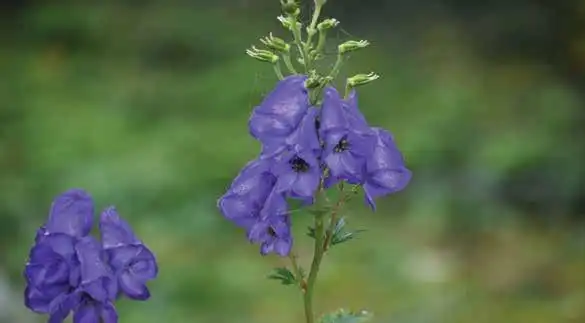
4 minute read
Toxic Plants
from Alconbury Feb 2022
by Villager Mag
Caroline Knight: Gardendesignideas.co.uk
Things to avoid in the garden
Advertisement
We all know that gardens are good for us. The effects of gardening on mind and body have been well-documented in terms of mental and physical health, as well as the increased possibilities of social interaction that can arise through tuning in to the outdoor world. Indeed, the biophilia hypothesis explains the huge benefits to be gained from making connections with nature. But there are also a few dangers out there and it’s wise to consider any potential hazards too! Some plants are harmful and it’s essential to know which are poisonous for people and pets. If you are
intent on creating a sensory-type garden or your outside space is a playground for pets and kids, for example, it’s important to make it as safe as possible. Animals and young children tend to explore the world around them using their senses of touch, smell, taste and sound; they are not quite so tuned in to sight. Some plants will cause a slight upset stomach but others are capable of damaging organs if enough is eaten. A few plants are extremely poisonous and can even cause death, although this is very rare.
Toxic plants
We are designed to eat produce including fruit, vegetables and herbs. Some need to be cooked before consumption, whilst others can be eaten raw. Potatoes, for example, should never be eaten raw because they contain potentially toxic compounds called glycoalkaloids which are non-digestible. Brussels sprouts can cause too much gas in the intestines if eaten raw. It’s worth bearing this in mind if your child likes to grub about in the allotment or kitchen garden. The leaves of rhubarb are highly toxic and even the leaves of tomatoes will cause gastro-intestinal distress. We love to eat the stems To advertise in The Villager and Town Life please call 01767 261122
27



of asparagus, but the little red berries are toxic. Pets such as dogs and cats are unable to consume some foods that are fine for humans. They include grapes, which can cause renal failure, several members of the onion family including leeks, and some mushrooms.
Some of the most poisonous plants in the UK
• One of the most toxic plants in the UK is monkshood, Aconitum napellus, also known as wolfsbane. Harry Potter fans will be familiar with this one, as even in the fictional wizarding world the potion is highly dangerous! It is a tall plant that produces beautiful purple-blue flowers in summer.
They look rather like a monk’s habit, hence the common name. Despite the fact that touching the leaves and then eating even a small part, or allowing entry of the plant via an open wound, can lead to fatal poisoning, this plant is widely available for planting within gardens. It doesn’t always come with a warning. • The death-cap mushroom, Amanita phalliodes.
This is a fairly common fungus here in the UK, growing in mixed deciduous woods, particularly under oak and beech trees. It’s quite a large mushroom, growing up to 15cm across with a domed, white cap. It looks similar to several edible mushrooms but is deadly poisonous. Some call it the silent assassin and only a small amount can result in death. It contains a toxin for which there is no known cure. • Hemlock, Conium maculatum is a highly poisonous flowering plant that is a member of the carrot family. It has a rather attractive umbel flower and purple spots on the green stems. It’s common in the UK, growing by hedges, ditches and woodland edges. All parts of the plant are toxic because of a fast-acting poison called cicutoxin. This causes stomach upsets and even paralysis of the lungs.
The Greek philosopher, Socrates, was said to have died after being poisoned by tea made from this plant. • Deadly nightshade, Atropa belladonna, is obviously poisonous – the clue is in the common name! It’s actually the fruits that are the biggest problem on this tall, bushy plant that likes shady and wooded areas. It produces bell-shaped flowers in early summer followed by black berries that can grow to the size of cherries. They look tempting to eat but contain the toxins atropine and scopolamine, which cause paralysis to organs, including the heart. It’s a potential killer in severe cases. • Giant hogweed, Heracleum mantegazzianum, has rightly earned a reputation for being one of
Britain’s most dangerous plants. It probably won’t kill, but it burns severely due to its toxic sap, which reacts with human skin and sunlight. It’s a huge beast, growing up to 4.5 metres tall, with umbrellashaped white flower clusters. • Even foxgloves are poisonous, if consumed. They contain digitalis and other chemicals that affect the heart. The pretty, bell-shaped, tubular flowers are just the right size for little fingers, so you won’t want these transferred into the mouth.











